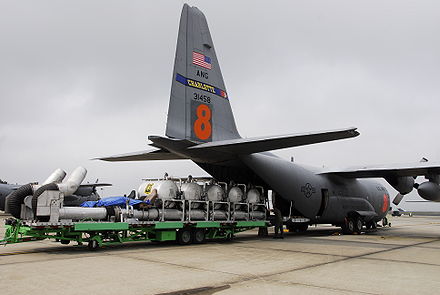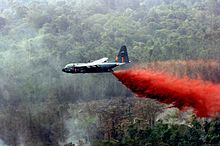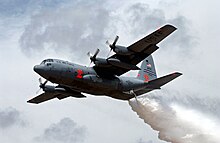Modular Airborne FireFighting System: Difference between revisions
→Development: New MAFFS II used for first time on a fire |
→Development: http://www.ng.mil/news/archives/2010/07/071610-Fires.aspx |
||
| Line 17: | Line 17: | ||
[[Aero Union]], under contract to the USFS, is currently developing an improved version of the system, the MAFFS II. The new system will have a capacity of up to 3,400 gallons, replacing the five retardant tanks with one large tank, and has an on-board air compressor. The original MAFFS has to be pressurized by a compressor on the ground as a part of the loading process. The ability to pressurize the system in the air will cut turn-around time.<ref name=usfs4>[http://www.fs.fed.us/fire/aviation/fixed_wing/maffs_II/index.html MAFFS 2 information from USFS]</ref> The new system will discharge the retardant through a special plug in the paratroop drop door on the side of the aircraft, rather than requiring the cargo ramp door to be opened; this allows the aircraft to remain pressurized during the drop sequence.<ref name=au1>[http://www.aerounion.com/Files/Forest_service_accepts_MAFFS_II.pdf?article.asp?article=articleRotation/president_message.asp&nav=nav1 Aero Union press release, July 27, 2007]</ref> |
[[Aero Union]], under contract to the USFS, is currently developing an improved version of the system, the MAFFS II. The new system will have a capacity of up to 3,400 gallons, replacing the five retardant tanks with one large tank, and has an on-board air compressor. The original MAFFS has to be pressurized by a compressor on the ground as a part of the loading process. The ability to pressurize the system in the air will cut turn-around time.<ref name=usfs4>[http://www.fs.fed.us/fire/aviation/fixed_wing/maffs_II/index.html MAFFS 2 information from USFS]</ref> The new system will discharge the retardant through a special plug in the paratroop drop door on the side of the aircraft, rather than requiring the cargo ramp door to be opened; this allows the aircraft to remain pressurized during the drop sequence.<ref name=au1>[http://www.aerounion.com/Files/Forest_service_accepts_MAFFS_II.pdf?article.asp?article=articleRotation/president_message.asp&nav=nav1 Aero Union press release, July 27, 2007]</ref> |
||
Aero Union delivered the first production unit to the USFS in July, 2007, and will be flight tested during August.<ref name=au1/> MAFFS II was used for the first time on a fire in July 2010 |
Aero Union delivered the first production unit to the USFS in July, 2007, and will be flight tested during August.<ref name=au1/> MAFFS II was used for the first time on a fire in July 2010, <ref>http://wildfiretoday.com/2010/07/16/new-maffs-ii-used-for-first-time-on-a-fire/</ref> using the latest generation [[Lockheed Martin C-130J Super Hercules]] aircraft. <ref>http://www.ng.mil/news/archives/2010/07/071610-Fires.aspx</ref> |
||
==Operations== |
==Operations== |
||
Revision as of 07:21, 9 October 2010

The Modular Airborne FireFighting System or MAFFS is a self-contained unit used for aerial firefighting that can be loaded onto a C-130 Hercules, a military cargo transport, which then allows the aircraft to be used as an air tanker against wildfires.[1] This allows the U.S. Forest Service (USFS) to utilize military aircraft from the Air National Guard and Air Force Reserve to serve as an emergency backup resource to the civilian air tanker fleet.[1][2]
Development
Congress established the MAFFS program after the 1970 Laguna Fire overwhelmed the existing aviation firefighting resources.[2] The USFS was directed to develop a program in cooperation with the Air National Guard and Air Force Reserve to produce the equipment, training and operational procedures to integrate military air tankers into the national response system. The Engineered Systems Division of FMC Corporation (Santa Clara, CA) was contracted to design, build and test the modular tank system that would enable a standard C-130 to be quickly converted into a tanker. Initial flight tests with a prototype two-tank installation began in July 1971.[3] Subsequent systems were fabricated by Aero Union of Chico, California.

The MAFFS consists of a series of five pressurized fire retardant tanks with a total capacity of 2,700 gallons and associated equipment which is palletized and carried in the aircraft's cargo bay.[2] In addition to the retardant tanks, each module contains a pressure tank where compressed air is stored at 1200 psi. The control module includes the master control panel, the loadmaster's seat, and discharge valves. An air compressor module provides air pressure for charging the system; it stays at the airtanker base during air operations and is used to recharge the system between runs. Each unit weighs about 11,000 pounds, with a load capacity of 2700 gallons. It can be installed in any C-130-E or -H equipped with the USAF 463L cargo-handling system.[1]

Air tankers are categorized by their retardant capacity, and although the MAFFS capacity is just under 3,000 gallons, a MAFFS C-130 is considered a Type 1 air tanker, which is the largest class.[4][5] Retardant exits through two tubes which extend out the plane's aft cargo bay doors. The system can disperse all 2,700 gallons in five seconds over a fire, producing a fire line that is 60 feet (18 m) wide and a quarter mile long. It can then be reloaded in eight minutes.[1][2]
MAFFS II

Aero Union, under contract to the USFS, is currently developing an improved version of the system, the MAFFS II. The new system will have a capacity of up to 3,400 gallons, replacing the five retardant tanks with one large tank, and has an on-board air compressor. The original MAFFS has to be pressurized by a compressor on the ground as a part of the loading process. The ability to pressurize the system in the air will cut turn-around time.[6] The new system will discharge the retardant through a special plug in the paratroop drop door on the side of the aircraft, rather than requiring the cargo ramp door to be opened; this allows the aircraft to remain pressurized during the drop sequence.[7]
Aero Union delivered the first production unit to the USFS in July, 2007, and will be flight tested during August.[7] MAFFS II was used for the first time on a fire in July 2010, [8] using the latest generation Lockheed Martin C-130J Super Hercules aircraft. [9]
Operations
MAFFS equipment is stationed at eight locations around the country. They are considered a "24-hour resource", meaning that when activated, it is expected that it will take 24 hours for the aircraft to arrive on scene, as the C-130s have to be pulled from their regular military duties and fitted with the MAFFS equipment.[10] When needed, regional foresters can request a MAFFS activation after they have ascertained that all available commercial air tankers are assigned to on-going incidents or committed to an initial attack.[11] The National Interagency Coordination Center at the National Interagency Fire Center (NIFC), Boise, Idaho, can activate the MAFFS when all other contract airtankers are committed to incidents or initial attack or are otherwise unable to meet requests for air operations. The request for MAFFS activation is approved by the national MAFFS liaison officer, who is the Forest Service director at NIFC. This request is then forwarded to the joint director of military support at the Pentagon. Governors of states where National Guard MAFFS units are stationed may activate MAFFS for missions within their state boundaries when covered by a memorandum of understanding with the military authority and the Forest Service.[1]

During the 1994 fire season, one of the worst that decade, the four airlift wings equipped with MAFFS flew nearly 2,000 missions and dropped 51 million pounds of retardant.[12] In 2004, after all the large civilian tankers in the U.S. had been grounded due to safety concerns, MAFFS-equipped C-130s were pre-positioned in western states in anticipation of wildfires.[13] Besides use on U.S. fires, MAFFS has been deployed to Europe, Africa and Indonesia. International deployment is initiated by a foreign government's request through the U.S. State Department.[11]
The military is reimbursed for the cost of operating MAFFS flights by the agency having jurisdiction over the fire.[10]
MAFFS is in use in the Brazilian Air Force C-130.
Training

MAFFS crews are trained every year with USFS aviation operations personnel. The training is coordinated with the Air Force Reserve's 302d Airlift Wing at Colorado's Peterson Air Force Base, the Air National Guard's 153d Airlift Wing from Cheyenne, Wyoming, the 146th Airlift Wing from Port Hueneme, California, and the 145th Airlift Wing from Charlotte, North Carolina.[1]
References
- ^ a b c d e f MAFFS system description, U.S. Forest Service web site
- ^ a b c d "Modular Airborne FireFighting Systems", U.S. Forest Service web site
- ^ Francillon 1993, pp. 73–74.
- ^ "Interagency Standards for Fire and Aviation Operations 2007, Chapter 17" (PDF). National Interagency Fire Center. Retrieved 2007-08-31.
- ^ Air tanker listing by type, from Associated Airtanker Pilots website
- ^ MAFFS 2 information from USFS
- ^ a b Aero Union press release, July 27, 2007
- ^ http://wildfiretoday.com/2010/07/16/new-maffs-ii-used-for-first-time-on-a-fire/
- ^ http://www.ng.mil/news/archives/2010/07/071610-Fires.aspx
- ^ a b California Department of Forestry MAFFS information
- ^ a b MAFFS policy and responsibilities
- ^ 146th Airlift Wing MAFFS information
- ^ "Firefighting aircraft deploy to Arizona", USAF press release, 2004-05-25
- Francillon, René J. "Volant Forest: Fire-fighting MAFFS Herks". Air International, August 1993, Vol 45 No 2. Stamford, UK:Key Publishing. pp. 73–78. ISSN 0306-5634.
External links
- Western Fires!: Reserve, Air Guard C-130s help fight California forest fires, USAF article
- 302nd Airlift Wing MAFFS photo gallery
- MAFFS fact sheet from CDF
See also
![]() This article incorporates public domain material from websites or documents of the United States Department of Agriculture.
This article incorporates public domain material from websites or documents of the United States Department of Agriculture.
